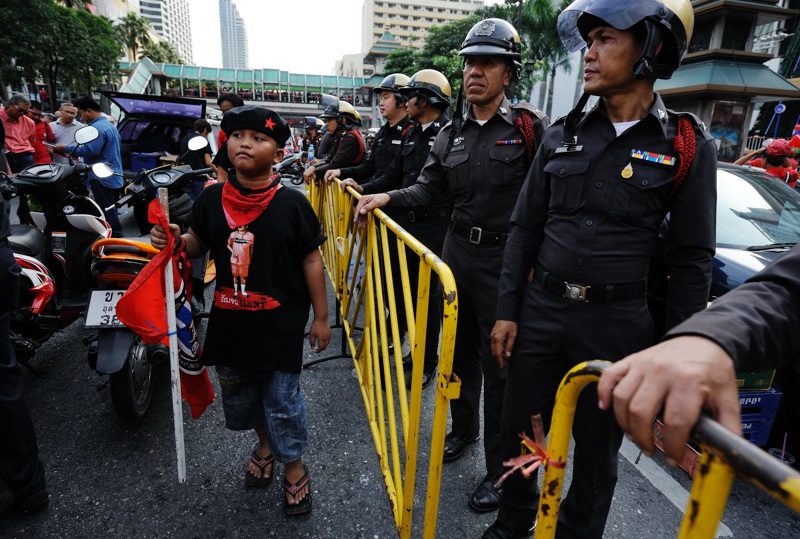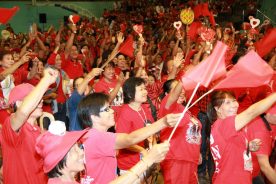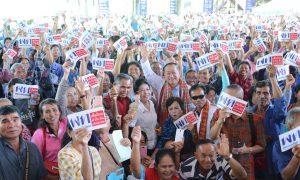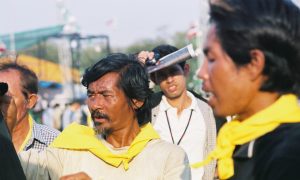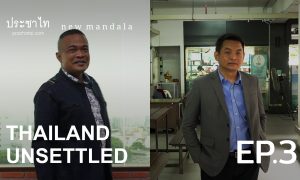Thailand’s previously outright dictatorship is now wearing a fig leaf of parliamentary democracy. After being on “freeze” for five years, politics is heating up again and the country seems more divided than ever—but along what lines?
With Pheu Thai’s relatively lacklustre performance in the recent elections, as well as the emphatic arrival of Future Forward, some analysts claim a shift has occurred in Thailand’s troubled politics.
“The era of Red versus Yellow is over,” proclaimed Andrew MacGregor Marshall shortly after May’s election. “Now the conflict is clearer—democracy versus dictatorship, freedom versus royal worship, the future versus the dinosaurs.”
A recent op-ed by former Australian ambassador James Wise concurred, declaring the end of “Red versus Yellow” politics and the emergence of “two new poles: pro-military or anti-military.”
And in a Bangkok Post column, political scientist Thitinan Pongsudhirak argues that the “newer fault lines are generational and ideological in orientation”. If the generation gap is not sufficiently bridged, Thailand is headed towards “a different kind of conflict, no longer centring on Thaksin and his opponents, but between people who grew up during the Cold War and those who were reared in the 21st century.”
The above statements offer insufficient explanations, not only of what Thailand’s political crisis was about during the so-called “Red versus Yellow” era, but what it will continue to be about going forward—because nothing has substantially changed.
The Red Shirts are reviled by many Thais, who consider them an “infection of the Thai moral-political body”. It is attractive for these Thais to declare an end to the era of “Red verses Yellow”, because it means the “virus” has been cured and all is well again in the country. Meanwhile for outside observers, the depth of hatred towards the Red Shirts, their association with Thaksin, and the willingness of a minority of the movement to engage in violence has made it difficult to bestow on them the morally-affirming title of “democracy movement”. The desire to wade out of these muddied waters and search for a clearer view is understandable.
But the Red Shirts have always been about electoral politics and representation—the same “democracy versus dictatorship” cleavage that commentators argue has fractured Thailand since the election. From their origins as a broad church opposed to the 2006 coup, on to their days opposing the questionable transfer of power to Abhisit Vejjajiva in 2008–11, then ending with their last mass rally to support the embattled Yingluck government at Aksa Road in 2014, the movement has always been fighting for these most basic necessary conditions for democracy. That a significant portion of society has pushed back so hard against the movement reveals a deep schism in Thai society, splintered along two divergent visions for the country.
On one side are those who wish for Thailand to be a nation-state in the modern sense, with all citizens having equal rights guaranteed by a constitution, to which even the monarchy is bound. State institutions, such as the courts, civilian bureaucracies and the military are to serve the public by administering the laws and policies of elected representatives.
On the other side are those who cling to vestiges of the past, with the monarchy at the centre of Thai life and those in its orbit enjoying an exalted status. The “servants of the king” (ข้าราชการ) in the vast bureaucracies run the country at his behest and secure certain privileges in doing so. So too does the military, which retains a special prerogative to involve itself in politics. From this perspective, the concept of the Thai nation is not, to quote Benedict Anderson, one of “deep, horizontal comradeship” but a vertical hierarchy, in which some Thais are considered inferior to others. This is especially true of those from peripheries like the north and the northeast, which were once tributary states of Siam.
Naturally, these two competing visions—equality in representation, and a hierarchy of rule—overlap to a large extent with other cleavages in Thai society: centre/periphery, urban/rural, affluent/ lower income, state employee/informal sector, etc. The so-called “Red versus Yellow” era of Thai politics has been variously—and correctly—described as a regional, ethnolinguistic and class-based divide.
But while these are accurate descriptions of the fault-lines, they tell us nothing about what made these divisions political and explosive: no less than the aforementioned ideological struggle over who gets to influence and be represented in national politics, and the form of political system that might facilitate that inclusion and representation.
So is the era of “Red versus Yellow” over? Arguably, it has been over for almost ten years already, since the yellow-shirted People’s Alliance for Democracy faded into insignificance and was superseded by other royal-nationalist groups, like Dr Tul Sitthisomwong’s “multi-coloured shirts”, General Boonlert’s Pitak Siam and Suthep Thaugsuban’s whistle-blowing People’s Democratic Reform Council. But regardless of what colour they actually wore, these movements were all cut from the same “yellow” cloth.
It has also been many years now since a mass-mobilisation of Red Shirts took to the streets. But the movement has remained active as a social club of sorts, organising frequent gatherings at its hub in Bangkok’s Imperial Lad Prao mall. Smaller, local chapters and informal groups also meet regularly around the country. Unlike their “yellow” counterparts, the Red Shirts never felt the need to “rebrand” and the “red” identity has remained strong in the minds of many who took part in the movement. The red t-shirts they wore, the membership cards they carried and other paraphernalia have been carefully stored, kept away from the prying eyes of any military officers who might pay an unwelcome visit.
If the movement never rallies under the red banner again, it hardly matters. Any future mass political mobilisation will feature many of the same faces who made up the Red Shirt crowds, just as it was with the various incarnations of the royal-nationalist movements. And the two sides will still be rallying around the same two competing visions of Thailand described above, which remain unresolved.
It’s easy to see why Future Forward Party and the new generation of democracy activists in its orbit are more attractive to observers than the Red Shirts. They are youthful, well-educated, urbane and creative. The party leadership is charismatic and untainted by scandal and baggage from the past. It is also more cosmopolitan in its outlook and better able to articulate its platform to an international audience.
But Future Forward has always had a closer relationship to the Red Shirts than many would like to admit, evidenced by the ease with which it formed a “democratic bloc” with Pheu Thai after the election. The royal-nationalists are well aware of this, which is why the party and its supporters are on the receiving end of venom previously reserved for the Red Shirts and Thaksin.
It’s true that Thailand’s existential angst has broadened to include a new demographic. A curious feature of the earlier stages of the conflict was that most of the protagonists on both sides were well into their 50s and 60s. In their youth, many of them were part of a generation touched deeply by the political upheaval of the 1970s, reminding us that the struggle over Thailand’s identity is not new. Younger Thais in the 21st century seemed to take little interest in politics—until now.
Yet it’s also inaccurate to say Thailand is on the cusp of a generational conflict. How can it be when the older generation remains deeply divided amongst itself? Young Thais aren’t rebelling against the older generation per se but are opposing the backwards vision of the royalist-conservatives. And by coalescing around the more progressive of the two competing ideologies, they have ended up as fellow travellers of the Red Shirts. This unlikely alliance goes back to the early protests of the youth-led New Democracy Movement in 2015, which were attended by student activists and older Red Shirts in equal measure. The kinship is still evident today, such as when political hip-hop group Rap Against Dictatorship are handed flowers by adoring Red Shirt “aunties” more than twice their age.
The success of Phalang Pracharath and Future Forward in the recent election suggests the middle ground is collapsing, as more Thais flock to new parties embodying different visions of Thailand more emphatically than before. Despite serious question marks over the election, it’s clear many Thais did vote for the pro-junta party. This suggests a hardening of attitudes among the royal-nationalists, whose sense of ontological security has been threatened by decades of societal change, the trauma of the recent political turmoil and the passing of King Bhumibol.
Cooptation doesn’t work: how redshirts voted in Isan
The redshirt movement endures at the ballot box.
The arrival of a new, youthful politics has been evident for some time. Even before Future Forward Party arrived on the scene, political opinions were being printed on t-shirts, spray-painted on walls and belted out in song lyrics. Young creatives and influencers led the way, making it easier for others to follow. Living for five years under “Uncle” Prayuth’s military rule was just so uncool that the cool kids had to rebel. And the royal-nationalists were so aggressive, unreasonable and shameless in their determination to push their vision of Thailand on the rest of the country that they alienated a large section of the Thai youth in the process.
Some analysts have wondered whether—if parliamentary means fail, which seems likely—the newly politicised youth could be mobilised for protests. A better question would be: how successfully could a pro-democracy alliance of “futuristas” and Red Shirts be mobilised? Such a cross-class, cross-generational movement certainly seems possible nowadays.
The “Red versus Yellow” era isn’t quite over in Thailand, at least not in the sense of the core issues that divide the two movements. The underlying causes of Thailand’s troubles have not changed. But a new “Red and Orange” alliance might be in the making—and it could have far-reaching consequences if it transpired.
ประชาธิปไตยไทยขณะนี้เหมือนใบบัวที่ห่อหุ้มการปกครองแบบเผด็จการไว้ หลังจากที่ถูกแช่แข็งมาร่วมห้าปี การเมืองไทยขณะนี้ก็กลับมาร้อนระอุอีกครั้ง และมีการแบ่งฝักแบ่งฝ่ายกันมากยิ่งกว่าเดิม—แต่จะแบ่งกันเป็นแนวไหน
การที่พรรคเพื่อไทยขาดประสิทธิภาพในการเลือกตั้งครั้งที่ผ่านๆมา ประกอบกับการปรากฏตัวของพรรคอนาคตใหม่ ทำให้นักวิเคราะห์บางท่านคิดว่ามีการเปลี่ยนแปลงบางอย่างเกิดขึ้นในการเมืองไทย “ยุคสีแดงสีเหลืองมันจบไปแล้ว (The era of Red versus Yellow is over)” แอนดรูว์ แม็กเกรเกอร์ มาร์แชลล์ ประกาศไว้หลังจากการเลือกตั้งเดือนพฤษภาคม “ตอนนี้ความขัดแย้งยิ่งชัดเจนขึ้นไปอีก—ประชาธิปไตยปะทะเผด็จการ อิสระภาพเจอกับการเทิดทูนบูชาราชวงศ์ อนาคตกับเหล่าไดโนเสาร์”
เมื่อไม่นานมานี้ เจมส์ ไวส์ อดีตนักการทูตประเทศออสเตรเลีย ก็ได้เขียนความเห็นกล่าวถึงการสิ้นสุดของการเมือง “แดงกับเหลือง” และการอุบัติขึ้นของ “สองขั้วใหม่ ฝ่ายสนันสนุนทหารหรือฝ่ายต่อต้านทหาร”
ฐิตินันท์ พงษ์สุทธิรักษ์ นักรัฐศาสตร์ ตั้งข้อสังเกตไว้ในบทความหนังสือพิมพ์บางกอกโพสต์ว่า “เส้นแบ่งทางความคิดที่เกิดขึ้นใหม่นั้นเป็นเรื่องของยุคสมัยและอุดมการณ์ (Newer fault lines are generational and ideological in orientation)” หากไม่มีการเชื่อมช่องว่างระหว่างวัยอย่างเพียงพอ ประเทศไทยก็จะมุ่งเข้าสู่ “ความขัดแย้งที่ไม่ได้เกี่ยวเนื่องกับทักษิณและอริของเขา แต่เป็นความขัดแย้งระหว่างประชาชนที่เติบโตในช่วงยุคสงครามเย็นกับประชาชนที่เติบโตในช่วงปลายศตวรรษที่ 21
ข้อความด้านบนเหล่านั้นไม่ได้ให้คำอธิบายอย่างเพียงพอว่าวิกฤติทางการเมืองของประเทศไทยในยุคที่เรียกกันว่า “แดงปะทะเหลือง” นั้นคืออย่างไรแน่ อีกทั้งไม่ได้อธิบายการคาดการณ์ว่าต่อไปจะเป็นอย่างไรแม้แต่น้อย เพราะที่จริงแล้วสาระสำคัญของสถานการณ์การเมืองของประเทศไทยก็ไม่ได้เปลี่ยนแปลงไปเลย
คนไทยหลายคนประจานกลุ่มคนเสื้อแดงว่าเป็นเชื้อร้ายต่อร่างกายการเมืองไทย ดังเช่นที่ ธงชัย วินิจจะกูล กล่าวไว้ ขณะเดียวกันในมุมมองของผู้สังเกตการณ์ภายนอก การได้เห็นความเกลียดชังที่หยั่งรากลึกของคนที่มีต่อกลุ่มคนเสื้อแดง และต่อการที่กลุ่มคนเสื้อแดงคบค้าสมาคมกับทักษิณ หรือการสมัครใจใช้กำลังในการเคลื่อนไหวแม้เพียงส่วนน้อยก็ทำให้ผู้สังเกตุการณ์เกิดความรู้สึกขัดแย้งในใจกับการที่จะเรียกการเคลื่อนไหวเหล่านั้นว่าเป็นการเคลื่อนไหวเพื่อประชาธิปไตย ดังนั้นเสมือนกับว่าได้ขจัดความรู้สึกที่เหมือนน้ำขุ่นออกไป จึงเป็นการดีที่ได้ประกาศว่ายุคของ “แดงปะทะเหลือง” ถึงกาลอวสานแล้ว เพราะนั่นหมายถึงว่า “เชื้อร้าย” ได้รับการรักษาและทุกอย่างในประเทศได้กลับมาสู่สภาพปกติอีกครั้ง
คนเสื้อแดงมักจะออกมาเคลื่อนไหวเพื่อการเลือกตั้งและการเลือกผู้แทน ซึ่งประเด็นก็ไม่ได้แตกต่างออกไปจาก “ประชาธิปไตยปะทะเผด็จการ” ที่นักวิจารณ์ทั้งหลายเอ่ยถึงว่าเป็นสาเหตุของการแบ่งแยกประเทศไทยจากการเลือกตั้งครั้งล่าสุด การเคลื่อนไหวทั้งหลายโดยคนเสื้อแดงที่เป็นไปเพื่อปัจจัยขั้นพื้นฐานสำหรับประชาธิปไตยนั้น เริ่มจากที่ผู้คนมากหน้าหลายตาออกมาต่อต้านการรัฐประหารในปี 2549 จนกระทั่งถึงวันที่มีการเปลี่ยนผ่านอำนาจไปยัง อภิสิทธิ์ เวชชาชีวะ ในปี 2551-2554 แล้วจบลงด้วยฝูงชนที่คราคร่ำกันมาสนับสนุนรัฐบาลของยิ่งลักษณ์ ณ ถนนอักษะ ในปี 2557 ต่อมาพอมีคนในสังคมจำนวนมากออกมาต่อต้านการเคลื่อนไหวเหล่านั้นก็แสดงให้เห็นถึงการแบ่งฝักฝ่ายที่ฝังลึกอยู่ในสังคมไทย และเป็นฝักฝ่ายที่เวียนวนอยู่กับสองแนวคิดที่แตกต่างกัน
แนวคิดหนึ่งคือกลุ่มคนที่หวังให้ประเทศไทยเป็นรัฐชาติสมัยใหม่ ที่ประชาชนมีสิทธิที่ได้รับการรับรองตามรัฐธรรมนูญอย่างเท่าเทียมกัน โดยความเท่าเทียมกันนี้ให้ผูกพันถึงราชวงศ์และองค์กรต่างๆของรัฐด้วย อีกทั้ง ศาล หน่วยงานราชการ และกองทัพ ให้มีหน้าที่เพื่อรับใช้สาธารณะ โดยอำนวยการตามกฎหมายและนโยบายจากผู้แทนที่มาจากการเลือกตั้ง
อีกแนวคิดหนึ่งคือกลุ่มคนที่ยึดติดอยู่กับเศษซากอดีต ที่มีสถาบันกษัตริย์เป็นศูนย์กลางของชีวิตประชาชนคนไทย โดยแนวคิดนี้ไม่สอดคล้องกับงานของเบเนดิกต์ แอนเดอร์สันเรื่องความสัมพันธ์ฉันท์มิตรสหายที่เท่าเทียมกัน (deep horizontal comradeship) กล่าวคือ ชาติไทยไม่ได้มีความสัมพันธ์เช่นมิตรสหายที่เท่าเทียมกัน แต่เป็นความสัมพันธ์ที่มีลำดับชั้นจากบนลงล่าง ที่คนไทยบางคนถูกตัดสินว่าด้อยกว่าคนอื่น โดยสิ่งนี้จะเห็นได้ชัดในกลุ่มคนที่มาจากแถบภาคเหนือและอีสาน ซึ่งครั้งหนึ่งเคยเป็นรัฐบรรณาการของสยาม
คนที่อยู่ตรงกลางวิถีโคจรของแนวคิดนี้ก็จะได้เสพสุขบนสถานะอันสูงส่ง เช่น บรรดาข้าราชการในหน่วยงานใหญ่ที่ได้รับโองการให้บริหารประเทศที่ได้รับประโยชน์จากการบริหาร และกองทัพที่ได้รับสิทธิพิเศษให้เข้ามาเกี่ยวกับกับการเมือง
เป็นเรื่องธรรมดาที่สองแนวคิดที่แตกต่างกันอย่างยิ่ง เช่น แนวคิดการมีผู้แทน กับ แนวคิดการมีลำดับชั้นการปกครอง จะแตกแขนงออกไปอย่างกว้างขวางเป็นความขัดแย้งในส่วนอื่นของสังคมไทย เป็นต้นว่า ส่วนกลางกับรอบนอก เมืองกับต่างจังหวัด คนมั่งมีกับคนยากไร้ ข้าราชการกับเอกชน ดังนั้นยุคที่เรียกว่า “แดงปะทะเหลือง” จึงจัดเป็นประเด็นความแตกต่างในทางพื้นที่ กลุ่มชาติพันธุ์ภาษา และชนชั้นวรรณะ เสียมากกว่า
ที่กล่าวไปทั้งหมดข้างต้นนั้นล้วนเป็นคำอธิบายที่ชัดเจนถึงแต่ละแนวคิดที่ต่างฝักต่างฝ่าย แต่กลับไม่ได้อธิบายถึงว่าอะไรคือสาเหตุที่ทำให้เกิดเป็นความขัดแย้งปะทุขึ้นมา อีกทั้งไม่ได้อธิบายถึงการดิ้นรนว่าใครจะเป็นตัวแทนด้านการเมือง และประเทศควรจะมีระบบการเมืองแบบใด
ฉะนั้น ยุค “แดงปะทะเหลือง” ยุติลงแล้วใช่หรือไม่? ถกเถียงกันว่ามันได้ยุติลงแล้วเกือบสิบปี ตั้งแต่สมัยที่กลุ่มคนเสื้อเหลืองพันธมิตรประชาชนเพื่อประชาธิปไตยลดบทบาท ผลัดมือให้กับกลุ่มชาตินิยมและฝั่งขวารายอื่น เช่น กลุ่มเสื้อหลากสีที่นำโดยนายแพทย์ตุลย์ สิทธิสมวงศ์ หรือองค์กรพิทักษ์สยาม นำโดยพลเอกบุญเลิศ แก้วประสิทธิ์ และม็อบนกหวีดหรือคณะกรรมการประชาชนเพื่อการเปลี่ยนแปลงประเทศไทย นำโดยสุเทพ เทือกสุบรรณ แต่ไม่ว่าพวกเขาจะย้อมเปลี่ยนสีเสื้อที่ใส่ออกมาเคลื่อนไหวอย่างไร ก็คงจะปิด “สีเหลือง” เดิมนั้นไม่มิด
การระดมพลขนาดใหญ่ของเสื้อแดงที่เข้าปิดถนนก็ผ่านไปแล้วหลายปี แต่พวกเขายังคงมีการเคลื่อนไหวอย่างต่อเนื่อง แต่เป็นไปในรูปแบบการพบปะสมาคม โดยที่กรุงเทพฯ มีศูนย์กลางการพบปะที่ศูนย์การค้าอิมพีเรียลลาดพร้าว และสำหรับกลุ่มเล็กๆที่ยิบย่อยลงไปนั้นก็มีการพบปะกันอยู่รอบนอก กลุ่มคนเสื้อแดง แตกต่างออกไปจากกลุ่มเสื้อเหลืองตรงที่พวกเขาไม่เห็นว่ามีความจำเป็นที่จะต้องเปลี่ยนสีเสื้อของตนเองแต่อย่างใด ตัวตนความเป็น “แดง” ยังคงยืนหยัดแข็งแกร่งสำหรับบรรดาผู้เข้าร่วมการเคลื่อนไหว เสื้อแดงที่สวมใส่ ความเป็นสมาชิกที่ยึดถือ และสิ่งละอันพันละน้อยจะถูกเก็บรวบรวมไว้ด้วยความระมัดระวัง ไกลจากสายตาสอดส่องของเจ้าหน้าที่ทหารที่อาจจะมาเยี่ยมเยือนโดยไม่ได้รับเชิญ
หากป้ายสีแดงไม่ได้ถูกนำออกมาชูขึ้นอีกก็ไม่ได้สลักสำคัญเนื่องจากว่าผู้เข้าร่วมการเคลื่อนไหวทางการเมืองก็คือคนคุ้นหน้าคุ้นตาที่มาจากกลุ่มคนเสื้อแดง เฉกเช่นเดียวกับกลุ่มคนเสื้อเหลืองยามออกมาเคลื่อนไหวภายใต้รูปลักษณ์ใหม่ในฐานะคนอุดมการณ์ขวาจัด และทั้งสองฝ่ายนี้ก็จะยังคงวนเวียนแข่งกันอยู่ร่ำไปไม่มีที่สิ้นสุด
ต่อมาเมื่อพรรคอนาคตใหม่พร้อมทั้งนักกิจกรรมรุ่นใหม่ปรากฎตัวขึ้น พวกเขาก็กลายมาเป็นหัวข้อที่น่าสนใจสำหรับผู้สังเกตการณ์ภายนอก ซึ่งก็เป็นเรื่องที่เข้าใจได้ไม่ยากนัก เนื่องจากพวกเขายังเยาว์ การศึกษาดี ทันสมัยและมีความสร้างสรรค์ หัวหน้าพรรคดูมีเสน่ห์และปราศจากเรื่องราวอื้อฉาวสะสมมาจากอดีต นอกจากนี้ยังมีความเป็นสากลและสามารถเข้าถึงได้
กระนั้นพรรคอนาคตใหม่กลับมีความสัมพันธ์ใกล้ชิดกับกลุ่มคนเสื้อแดงเกินกว่าที่ใครหลายคนจะยอมรับ โดยจะเห็นได้จากการที่พวกเขาจับมือกับพรรคเพื่อไทยภายหลังจากการเลือกตั้ง คนที่มีแนวคิดฝ่ายขวาเองก็รับรู้ในจุดนี้ จึงเป็นสาเหตุที่ทำให้พรรคอนาคตใหม่และผู้สนับสนุนของพรรคได้รับความรังเกียจเดียดฉันท์เช่นเดียวกับที่สงวนไว้สำหรับทักษิณและพรรคเพื่อไทย
ถ้าจะกล่าวว่าความทุกข์ตรมผสมกับความโกรธแค้นและสับสนของประเทศไทยที่สะสมมาช้านาน ได้ขยายอิทธิพลมาถึงคนรุ่นใหม่ด้วยแล้ว ก็ไม่ได้เป็นกล่าวเกินจริง แต่มีสิ่งที่น่าสนใจคือ ในช่วงเริ่มแรกของความขัดแย้งของสองฝั่งแนวคิดของไทยนั้น เราจะเห็นบรรดาแกนหลักส่วนมากจะอยู่ในช่วงอายุ 50-60 ปี นั่นหมายความว่าเหล่าแกนหลักนี้คือคนเดือนตุลา ผู้เคยมีประสบการณ์ด้านการเมืองที่โหมขึ้นมาก่อนแล้วตอนที่พวกเขายังเยาว์ และตรงนี้เองเป็นจุดที่ทำให้เห็นว่าการดิ้นรนเรื่องอัตลักษณ์ของประเทศไม่ใช่เรื่องที่เพิ่งจะเกิดขึ้น เพียงแต่ที่ผ่านมาคนไทยรุ่นยุคศตวรรษที่ 21 ไม่ค่อยได้ให้ความสนใจด้านการเมืองเท่าใดนัก เพิ่งจะมาสนใจกันก็ในขณะนี้
เราไม่ควรที่จะด่วนสรุปไปว่าประเทศไทยกำลังเผชิญกับความขัดแย้งอันเนื่องมาจากยุคสมัยและช่วงวัย ในเมื่อคนรุ่นก่อนก็ยังมีความขัดแย้งกันเอง คนไทยรุ่นใหม่ไม่ได้ต่อต้านคนยุคก่อนเสียทีเดียวเพียงแต่ว่าพวกเข้าต่อต้านผู้คนที่มีแนวคิดอุดมการณ์ฝ่ายขวา และยิ่งถ้าจะให้ควบรวมคนไทยรุ่นใหม่เข้ากับฝ่ายใดในสองขั้วความคิดที่ขัดแย้งกันอยู่ ก็คงจะต้องลงเอยที่ฝั่งที่มีความคิดหัวก้าวหน้ามากกว่า ดังนั้นพวกเขาจึงถูกตัดสินว่าเป็นเพื่อนร่วมทางของกลุ่มคนเสื้อแดงไปโดยปริยาย คล้ายกับครั้งการประท้วงของขบวนการประชาธิปไตยใหม่โดยกลุ่มนักศึกษาในปี 2558 ที่นอกเหนือจากนักศึกษาแล้วผู้เข้าร่วมยังคงเป็นกลุ่มคนเสื้อแดงในจำนวนที่เท่าๆกัน แม้ว่าการประท้วงในครั้งนั้นจะไม่ได้เกี่ยวข้องกับครั้งปัจจุบันนี้ แต่ความคล้ายคลึงกันในแง่ของการตัดสินควบรวมกันยังคงปรากฏชัด ตัวอย่างเช่น คุณป้าคุณน้าเสื้อแดงชื่นชมและสนับสนุนนักร้องวงฮิปฮอป Rap Against Dictatorship
แม้จะมีข้อสงสัยหลายประการเกี่ยวกับการเลือกตั้งครั้งล่าสุด แต่จากความสำเร็จของพรรคพลังประชารัฐและอนาคตใหม่ ก็สามารถกล่าวได้ว่าความเป็นกลางทางความคิดกำลังพังทลาย มีคนไทยที่รวมตัวกันเป็นกลุ่มก้อน สนับสนุนพรรคใหม่ๆที่มีแนวคิดหลากหลายมากขึ้น คนไทยอุดมการณ์ฝ่ายขวาที่ความมั่นคงทางภววิทยา (Ontological Security) ของพวกเขาได้แหลกสลายไป ก็ลงคะแนนให้กับพรรคทหาร แสดงให้เห็นถึงความคิดที่แข็งกร้าวขึ้น สืบเนื่องมาจากมาจากเหตุการณ์ความวุ่นวายทางการเมือง และการสวรรคตของพระราชาภูมิพล
และการที่คนไทยหลายคนแสดงความประสงค์ทางการเมืองโดยลงคะแนนให้กับพรรคอนาคตใหม่ ทำให้คนไทยอุดมการณ์ฝ่ายขวาเดือดดาล และทำให้สถานการณ์ของประเทศไทยยิ่งซ้ำร้าย แม้ว่าหลายคนจะหวังใจไว้ว่าพรรคนี้จะเป็นทางออกตรงกลางสำหรับความขัดแย้ง แต่เนื่องจากด้วยอุดมการณ์อันเยาว์วัยและการเข้าร่วมแคมเปญวิพากษ์วิจารณ์กฎหมายหมิ่นพระบรมเดชานุภาพในอดีต ทำให้พรรคอนาคตใหม่ถูกมองว่าเป็นพวกหัวรุนแรงและก่อให้เกิดความปลุกปั่นแตกแยกในประเทศไทย
การเข้ามามีบทบาทของการเมืองโดยคนรุ่นใหม่ได้มีขึ้นมานานแล้ว มีมาเสียก่อนตั้งแต่พรรคอนาคตใหม่จะปรากฏตัวขึ้น จะเห็นได้จากผู้สร้างสรรค์รุ่นเยาว์ที่แสดงความเห็นทางการเมืองปรากฏชัดบนสกรีนเสื้อยืด ปาดระบายไว้บนกำแพง และร้องกึกก้องออกมาจากเนื้อเพลง เพราะว่าการอยู่ภายใต้ “ลุงตู่” มานานถึงห้าปีมันช่าง “ไม่เท่” เสียจนพวกเขาต้องลุกขึ้นมาต่อต้าน กลุ่มชาตินิยมและอุดมการณ์ฝั่งขวาก็ช่างไร้เหตุผล ไร้ยางอาย และต้องการจะยัดเยียดความคิดของตัวเองที่มีต่อประเทศไทยมากจนพยายามที่จะกีดกันคนไทยรุ่นใหม่จำนวนมหาศาล
นักวิเคราะห์บางท่านตั้งคำถามว่า ถ้าความพยายามในรัฐสภาล้มเหลว ( อาจมีการระดมพลคนรุ่นใหม่ที่สนใจการเมืองออกมาเคลื่อนไหวเพื่อประท้วงหรือไม่ แต่คำถามที่ดีกว่านั้นคือ การระดมผลเพื่อร่วมมือกันออกมาเคลื่อนไหวระหว่าง “Futuristas” และคนเสื้อแดงจะประสบความสำเร็จอย่างไร จะว่าไปการเคลื่อนไหวที่มาจากกลุ่มคนที่สถานภาพและวัยต่างกันในปัจจุบันอาจเป็นไปได้ก็ได้
ยุค “แดงปะทะเหลือง” ยังไม่เชิงว่ายุติ อย่างน้อยที่สุดคือยังไม่ยุติในแง่ที่ว่าแกนหลักก็ยังคงแบ่งออกเป็นสองฝักฝ่ายและยังคงเป็นสาเหตุที่ซุกซ่อนอยู่ในปัญหาต่างๆของประเทศไทย ทว่า “แดงและส้ม” ที่กำลังจะมีขึ้นนั้นอาจมีพลังแผ่ออกไปได้ไกล ก็คงต้องรอดูกัน
 Facebook
Facebook  Twitter
Twitter  Soundcloud
Soundcloud  Youtube
Youtube  Rss
Rss 